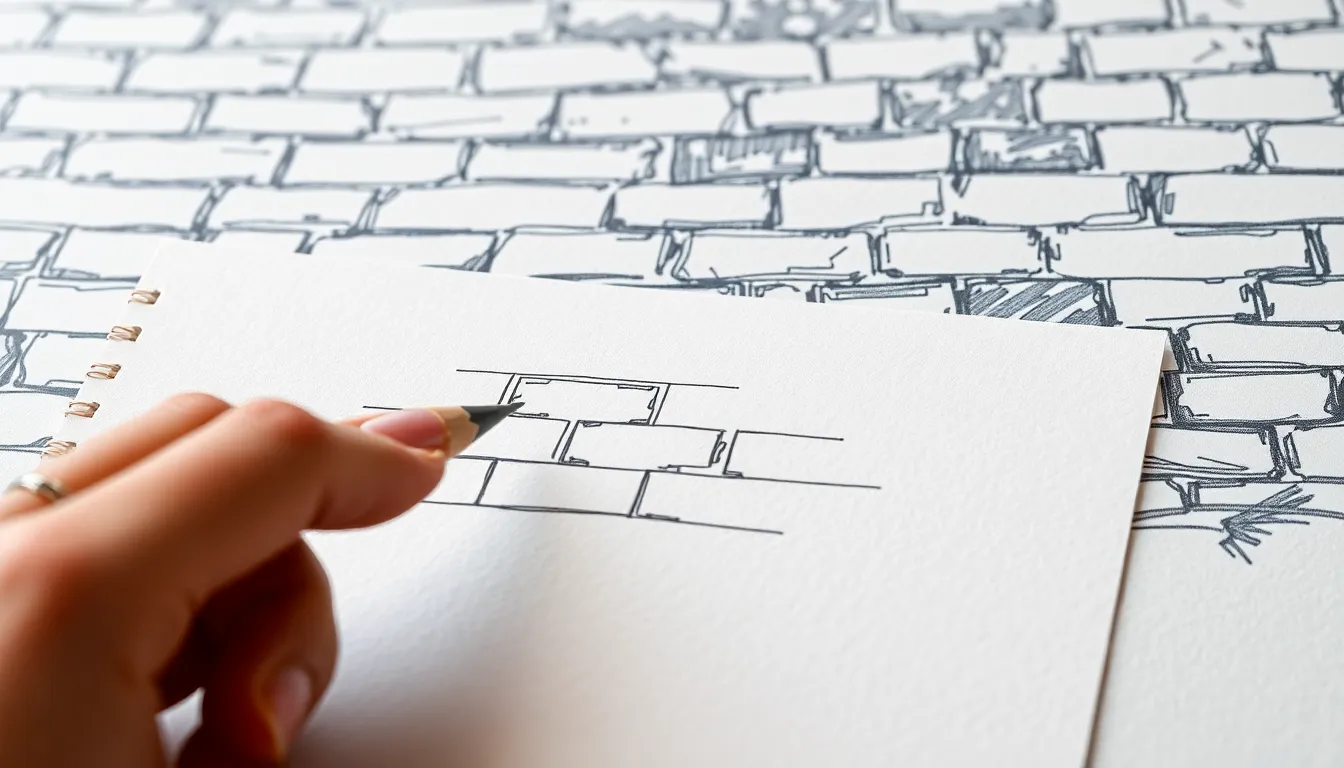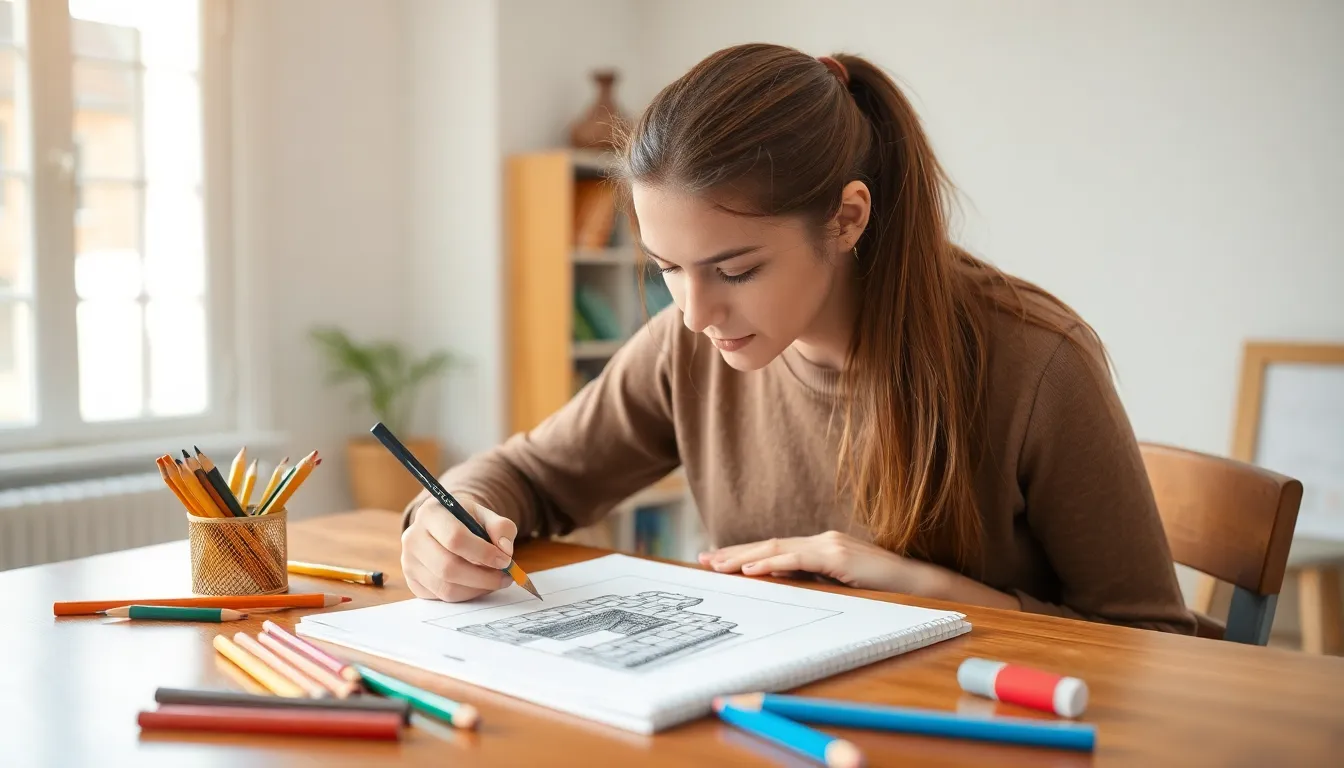Drawing bricks may seem like a simple task, but it’s an art form that can elevate any sketch from blah to brilliant. Whether you’re an aspiring architect or just trying to impress your friends with your doodling skills, knowing how to draw bricks opens up a world of creative possibilities. Who knew that mastering this humble building block could lead to endless artistic adventures?
Table of Contents
ToggleMaterials Needed
Drawing bricks requires a few essential materials. Pencils are crucial for sketching outlines and adding details. An eraser helps correct mistakes, ensuring clean lines and adjustments.
Markers or colored pencils enhance the look of bricks with vibrant colors and shading. These tools create depth and texture in the artwork. A ruler aids in drawing straight lines, ensuring uniformity in brick shapes.
Sketch paper or drawing pads provide a suitable surface for the drawing process. Using a thicker paper prevents ink from bleeding through, maintaining clarity. Watercolor paper is ideal if opting for paint.
If adding depth, consider using a blending stump. This tool smudges and blends pencil strokes for a smoother finish. Additionally, charcoal can create a dramatic look with its rich, dark hues.
Having the right materials significantly impacts the quality of brick drawings. Every tool serves a purpose in developing artistic skills. A well-equipped artist can achieve remarkable results in their creations.
Basic Techniques

Drawing bricks involves a few fundamental techniques. Mastering these techniques enhances the realism of brick structures in sketches.
Sketching the Outline
Begin by establishing the overall brick shape. Use a pencil to create a rectangular outline for each brick, ensuring consistency in size. Draw horizontal lines to define the layers. After that, include vertical lines to separate each brick within the layers. Adjust dimensions for perspective, making some bricks appear smaller than others for depth. Completing this step provides a clear framework to build on later.
Adding Texture
Creating texture adds realism to brick drawings. Use short, straight strokes along each brick’s surface to simulate the roughness of real bricks. Vary the pressure applied to the pencil for different effects. Consider focusing on areas where light and shadow naturally occur, enhancing the three-dimensional appearance. Incorporate small imperfections and variations in line to mimic real-life bricks. This attention to detail results in a more lifelike representation.
Detailed Steps
Mastering the techniques for drawing bricks involves understanding perspective and depth, as well as applying shading and highlights effectively.
Perspective and Depth
Creating perspective enhances the realism of brick drawings. Start by drawing bricks in varying sizes to simulate distance. Use a ruler to establish straight lines and maintain symmetry, while altering dimensions gives an impression of depth. Place larger bricks lower on the page for foreground emphasis, while smaller bricks appear higher for background effects. This technique introduces a three-dimensional illusion. Artists may incorporate vanishing points to guide the angle of the bricks effectively. Finally, layering bricks at angles can boost spatial perception, enriching the overall composition of the sketch.
Shading and Highlights
Applying shading and highlights brings bricks to life. Initially, choose a light source direction for consistency. Utilize darker shades along the edges of each brick to create shadows, reflecting how light interacts with surfaces. Artists can employ short, varied strokes to simulate texture, adjusting pressure for diverse effects. Incorporate lighter tones on the sides facing the light source to add dimension. Gradually blending shades further enhances realism, while leaving certain areas unshaded adds pops of brightness. This attention to detail ultimately results in lifelike brick structures on paper.
Creative Variations
Creative variations on brick drawing can enhance artistic expression. Artists can experiment with different brick sizes and shapes. By incorporating irregular bricks, one captures a more natural look. Textured surfaces add depth; consider using various shading techniques to highlight this.
Incorporating patterns into brick arrangements, such as herringbone or basketweave, creates visual interest. Artists can alternate colors too, moving beyond traditional reds and browns to include blues, greens, or even bright hues. These deviations spark creativity and challenge conventional designs.
Imagining brick structures in unconventional scenarios, like organic shapes or abstract forms, expands possibilities. Illustrating bricks within landscapes further allows artistic exploration. Blending realism with imagination illustrates unique stories in sketches.
Using digital tools can introduce new styles. Digital artists may apply filters or layers to manipulate textures. This modern approach offers flexibility in experimentation, allowing them to redefine traditional brick art.
Harnessing different perspectives, like aerial views or close-up shots, enriches the visual narrative. Artists should also consider seasonal themes, showcasing how bricks relate to their environment throughout the year. This contextual variation captures the essence of bricks in diverse settings.
Fusing cultural motifs into brick drawings is another effective technique. Artists can draw inspiration from architectural styles around the world. By incorporating these elements, they can craft globally influenced brick designs that resonate universally.
The exploration of creative variations not only enhances brick drawings but also fosters an enjoyable and innovative artistic journey.
Mastering the art of drawing bricks opens up a world of creative possibilities. With the right techniques and materials, artists can transform simple sketches into stunning representations of brick structures. By focusing on perspective, texture, and shading, they can achieve depth and realism that captivates viewers.
Encouraging experimentation with various shapes, sizes, and colors further enhances artistic expression. Whether using traditional methods or digital tools, the journey of drawing bricks inspires innovation and creativity. Embracing this skill not only enriches one’s artistry but also fosters a deeper appreciation for architectural details.




